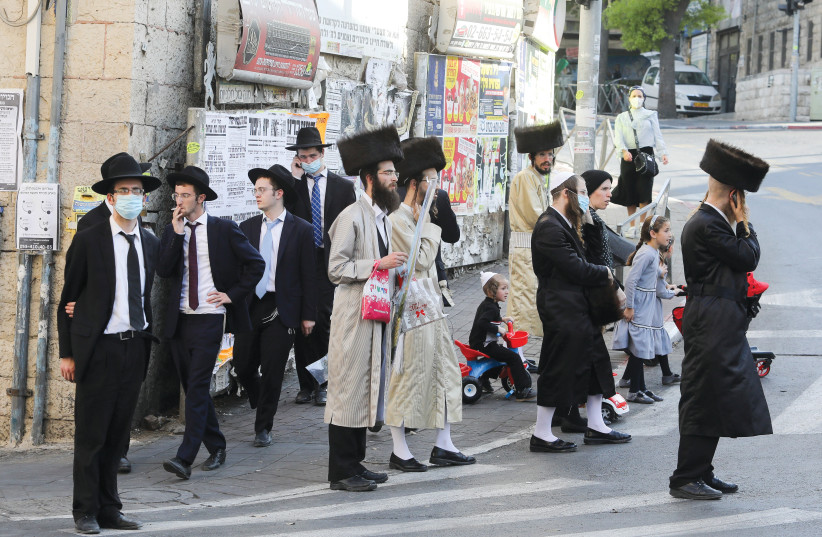
Myopia in youth can lead to glaucoma, vision loss, retinal detachment, cataracts – Israeli study
Not being exposed to daylight following long hours of study causes short-sightedness, leading to a trend in haredi boys
There have been a number of studies and theories about why a growing number of haredi (ultra-Orthodox) boys and teens suffer from shortsightedness (myopia), and nearly all of them have to wear corrective eyeglasses from a young age.
HAREDIM on a Mea Shearim street corner during Sukkot.
(credit: MARC ISRAEL SELLEM/THE JERUSALEM POST)
A study conducted in the optometry department at Hadassah College Jerusalem has found that not being exposed to daylight following long hours of study causes shortsightedness.
Dr. Einat Shneor, Dr. Ravid Doron, Dr. Jonathan Levine and Prof. Ariela Gordon Shaag collaborated with Dr. Lisa Ostrin and her partners from Houston, and the research was funded by the Israel-USA Binational Research Foundation. It was recently published in the prestigious journal Scientific Reports under the title “Baseline characteristics in the Israel refraction, environment, and devices (iREAD) study.”
The study
The study takes advantage of a unique situation in Israel, where Jewish boys study in three different systems: haredi, state National-Religious and state secular schools, each with different educational requirements.
A total of 57 haredi, 67 National-Religious and 44 secular boys ages six to 10 were recruited and underwent comprehensive vision tests. They wore a special Actiwatch that objectively measured exposure to daylight and physical activity. Questionnaires were distributed to the pupils’ parents to help analyze family history, close work, such as reading and writing, and use of screens.
Haredi boys’ education involves intensive, sustained near-work activity and long school days, beginning at age three. On the other hand, both boys and girls in the National-Religious and secular systems, as well as haredi girls, begin formal education at age six.
According to Shaag, who heads the Optometric Sciences Department at the college, “This is an important, targeted study, and if we understand what causes myopia among many of the haredi population, it will be possible to implement interventions to prevent development, for example, encouraging children to go outside during breaks at school.
Long-term impact of mopia
“During the research, I heard many haredim say, ‘So what if a child has myopia; he will only need glasses.’ Unfortunately, this is not true. There is a direct link between myopia and vision loss when they are older. Adults with myopia are also at increased risk of glaucoma, cataracts and retinal detachment. The more the child suffers from myopia at a young age, he is more likely to develop these diseases when he is older.”
Myopia is the most common cause of visual impairment worldwide, the team wrote. The prevalence of myopia is increasing, particularly in urban populations, such as those in Eastern Asia, the US and – of interest to the current study – Israel. Myopia is expected to affect half of the world population by 2050. The prevalence of high levels of myopia (≤-5.00D) is also increasing, with a reported eightfold increase from the 1970s to the 2000s.
Children’s refractive error is strongly associated with the number of myopic parents, but the prevalence is increasing faster than genetics alone can account for, thereby implicating a role of environment and behavior. Thus, the different rate of myopia between haredi boys and secular boys is considered to be the result of behavioral habits and not genetic factors.
The hypothesis of the study was that haredi boys would be less exposed to daylight and would be forced to spend more time looking at nearby materials (reading and writing, for example).
The prevalence of myopia varied by group (among the haredi sector, 46%; National-Religious, 25%; and secular, 20%). The amount of refraction (the number of the eyeglass lenses) was more negative (more myopia) in the group of haredi boys.
Haredi boys spent significantly less time outdoors than National-Religious and secular boys during the weekdays (haredi, half an hour to one hour a day, compared with significantly more among National-Religious and secular boys).
There were no differences on Shabbat. Secular boys were significantly less active than National-Religious and haredi boys on Shabbat. Haredi schools in Israel typically have 50 more school days than National-Religious or secular schools.
For example, the National-Religious and secular schools have summer break for all of July and August. In contrast, haredi schools only have three weeks of summer break from the 9th of Av until the 1st of Elul (typically in July or August).
When comparing children with myopia and children without myopia, it was found that more hours at school and at close work increase the chances of myopia. The haredi school curriculum consists mainly of religious studies. It is possible, according to the current research, that a long school day that includes a lot of reading contributes to myopia, the researchers said.
The research team suggested a number of interventions to prevent the onset and progression of it in this population that could reduce close-work demands and school hours.
View original article
